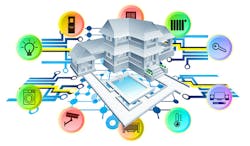You grab your suitcases, buckle in the kids, and finally head to the airport. As you reach your gate, you get that familiar inkling that you forgot to do something. Lock the door? I think so. Turn down the heater? Hmm. Turn off the lights? Hmm. Close the garage door? Yikes! Thank goodness for the Internet of Things—you can check all of these things remotely! You reach for your phone and double-check all your apps. Ahh, yes! You’re finally ready for mojitos on the beach knowing that your home is safe and powered off.
But what about last week when your kids told Alexa to turn off the lights at bedtime. Or when you told your smart oven to heat up the leftovers. How about when your smart doorbell alerts you every few minutes because it thinks someone is approaching your door, but it’s really just the leaves swaying in the trees.
All of this personal data first goes from the device to the cloud and back down again. Worse! It often goes to the voice-assistant cloud, then to a second cloud run by the light company, then back down to your light fixture. How ridiculous is that? Whether you care about it or not, lots of people are collecting all of this data on you and your family. Adding to these privacy and security concerns, are performance issues. What if the internet goes down or is super slow?
Cloud Cover
The fact of the matter is there’s a lot of data being sent to the cloud—and multiply that by all of us talking to all of our devices. This requires lots of cloud data centers. The cloud isn’t going away and is essential to making smart devices smart. Yet, according to an article in Wired, if each of the world's Android phones used Google voice services for just three minutes a day... the company would need twice as many data centers. That’s just considering Android phone data. Adding smart-home devices with voice, and devices with video and imaging data, is many orders of magnitude larger. That’s really a lot of data centers.
Cloud computing is still necessary for many IoT scenarios for functions like streaming music and real-time updates of news and weather. However, a new era of hybrid cloud/edge processing will be facilitated by more “local intelligence” on the device that lessens the need for (and risk of) being always connected to the cloud.
But does the cloud really need to know that you’re turning off the lights?
The short answer is “No” and here’s why.
Smart Edge AI
Advances in edge-based technology from Synaptics are helping make it possible to manage the processing burden and device-to-device communication for many of these functions locally on the device. This has direct benefits both in terms of the user experience as well as data security. We’re all in the dark if there’s an electricity blackout—go grab a candle and find a good book. But far more common is the internet going down and the time to bring it back up again.
With Synaptics’ Smart Edge AI and a simple LAN network in the home, you can remain lazy on the couch and still turn off the lights without your cloud internet connection. Smart Edge AI can enable features such as a 100,000+ word vocabulary in a voice-recognition capability without a cloud connection. In the case of a smart doorbell, Smart Edge AI ensures that video is streamed to your phone only when the package delivery person is there and not every time a bird flies by. This hybrid approach of combining local and cloud computing is the future of the smart home.
Devices performing edge compute functions are well-suited to provide better reliability and consumer privacy. By lessening the dependence and risk inherent in needing to send data to the cloud, Smart Edge AI will have an increasing IoT presence in environments such as the smart home, smart office, smart cities, and beyond.
Why Has it Taken So Long?
For the widespread adoption of smart-home devices to really take off, most consumers need to feel confident that their entire personal life isn’t in the hands of bad actors and advertising gurus. On top of that, users must be convinced that these devices are actually very useful or meaningful in their lives.
Smart Edge AI brings enterprise-grade security to the local (edge) hardware level. To implement a truly secure approach, an integrated solution that has the right sensor interfaces, a powerful application processor, and an optimized neural network accelerator all wrapped under the protection of a secure architecture, is required to deliver the security and meaningful capabilities desired by consumers.
Cost is also a big factor. Consider the cost of a smartphone, which can easily run well over $1,000. This is where most of the cool edge -rocessing breakthroughs and features are occurring today (did you see the 2019 Google I/O Keynotes using Pixel 3?!). This cost is simply not practical for smart-home hubs and other devices.
By using advanced AI-based neural networks and the processing horsepower to operate sub-$100 retail priced smart-home devices (enabled by Synaptics Smart Edge AI), the smart home can become the helpful home without breaking the budget.
Now that your knowledge about advances in edge computing is powered up, feel free to power down your brain and reach for that vacation mojito... so that you can take off (the other) edge.
Vineet Ganju is VP of Marketing, Edge Computing SoCs, at Synaptics.
About the Author
Vineet Ganju
VP of Marketing, Edge Computing SoCs
Vineet Ganju is a senior leader at Synaptics managing the company’s focus product lines of smart-home edge-computing SoCs with AI, and audio and video processors.


